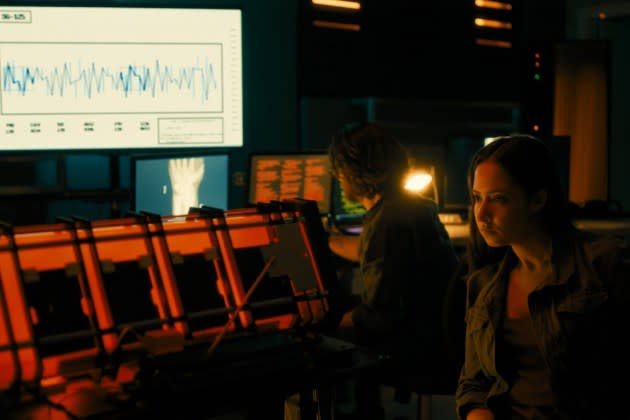‘The A-Frame’ Review: A Tonally-Awkward Sci-Fi Fable About Death

Calvin Reeder’s “The A-Frame” is chock-full of loaded ideas that don’t quite coalesce. A film about confronting death and a lurid fantasy of escaping its grasp, its story of terminal illness has the potential to be intensely personal. However, when it begins toying with sci-fi tropes and possibilities, it becomes both aesthetically and narratively malformed and feels lost in a liminal space between acerbic gallows humor and existential genre fiction without fully leaning into either one.
A therapy group for cancer patients, led by the thoughtful but to-the-point Linda (Laketa Caston), plays host to the movie’s wordy introduction and sets the stage for how the film expresses fear and desire. “The A-Frame” is a dialogue-heavy film. It relies on exposition for both its science-fiction concepts and its drama, which makes for an awkward disconnect with its protagonist: the sardonic 20-something Donna (Dana Namerode), who joins Linda’s ongoing session just after her diagnosis. Donna quips her way through dour situations, disguising her feelings beneath an impenetrable armor, albeit one whose surface the movie doesn’t probe beyond.
More from Variety
'A Desert' Review: Joshua Erkman's Debut Feature Is an Intriguing but Murky, Horror-Adjacent Mystery
'Sabbath Queen' Review: A Provocative if Cluttered Face-Off Between Different Notions of Judaism
Donna, a pianist who’s set to have her arm amputated to stop her cancer’s spread, is approached by an eager but skeevy scientist, Sam (Johnny Whitworth), who knows more about her than she would like, but presents her with an opportunity. Sam claims that his work — in a breakthrough field of quantum physics entirely unrelated to oncology — could prove helpful to Donna and others in her position, even as a last resort. But as Sam explains his methodology, in his low-lit, warm-toned workspace filled with screens and glowing panels, a visual inertia sets in. Reeder’s framing tends to be noncommittal. It’s neither wide enough to invite intrigue, nor close enough to feel vulnerable. His use of shadows, meanwhile, tends to obscure expression rather than create texture or dramatic contours.
Sam’s work in the realm of parallel realities turns out to have unintended side-effects on cancerous cells, but his methods remain untested, providing Donna with a series of dilemmas about whether to let herself (and other patients like her) become human guinea pigs. However, little actually comes of the movie’s frequent mentions of multiversal entanglement. A few flourishes emerge in the edit, in the form of kaleidoscopic imagery during scene transitions (these visually echo the idea of multiple, overlapping possibilities), but the idea never make its way into the actual story, despite the presence of whirring machines and lengthy, mad-scientist dialogue about other dimensions. What at first might seem like a film about faith and seeking desperate solutions in the face of death does in fact become highly literal about its genre concepts, but it ever opens the door to them, visually or thematically.
These limitations of imagination go hand-in-hand with limited filmmaking. The film’s directorial constraints become palpable during its many conversation scenes, when the editing becomes purely functional, cutting between dialogue from line to line as though information were more vital than emotion. The camera seldom lingers on Donna’s curiosity, on Sam’s greasy ambition or on any character’s gaze or sexual desire, which leaves its moments of physical intimacy feeling sudden and unpleasant.
“The A-Frame” does occasionally bloom when Donna’s friend Rishi (Nik Dodani), a stand-up comic coping with his diagnosis through humor, becomes a temporary focus. Dodani crafts enough comedy and drama through his pained reaction shots that the movie bursts to life when he’s in frame, though the same can’t be said for the rest of the cast, who — whether because of an innate difference in talent, or a discrepancy in how they were directed — feel shackled to the words on the page and never seem to read between them.
The movie’s most visceral confrontation of death comes in the form of an innovative body-horror detour. It’s extremely brief, but injects a fleeting tactility into a story about flesh and blood that otherwise treats cancer as a distant, theoretical concept to be talked through in broad platitudes about acceptance. However, this too ends up approached in contradictory ways — part pity, part cosmic justice — that don’t quite mesh and only exacerbate the movie’s issues of tone.
It’s rarely clear when “The A-Frame” is trying to be funny, poignant or deadly serious because most of its performances are designed to obscure, rather than reveal, and little in the filmmaking is geared toward creating visual meaning. It’s not nearly detailed enough in its exploration of death through a genre lens and ends up far too guarded, inexpressive and incurious for a film about such an intimate subject.
Best of Variety
Sign up for Variety’s Newsletter. For the latest news, follow us on Facebook, Twitter, and Instagram.

 Yahoo News
Yahoo News 